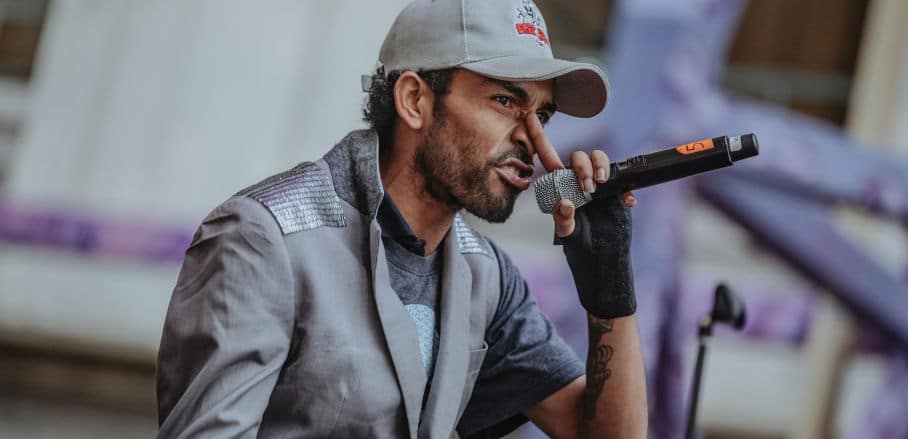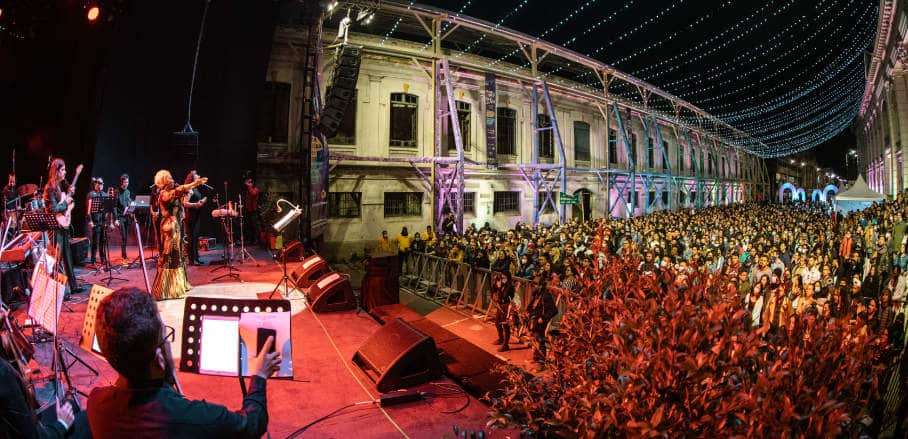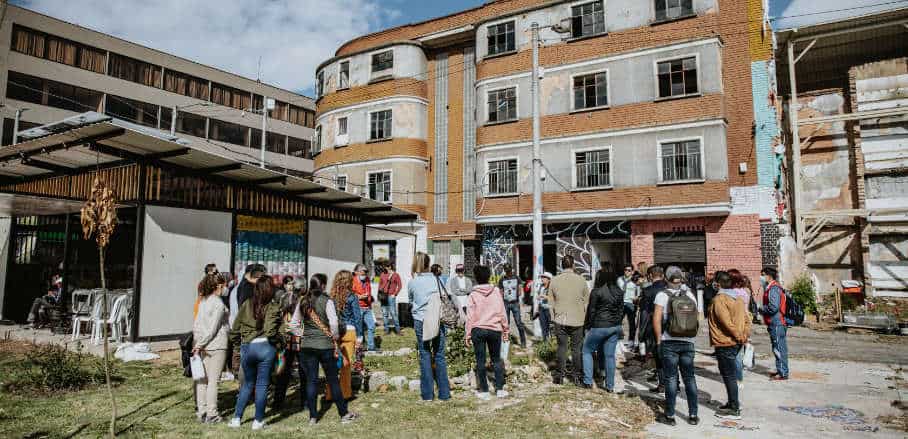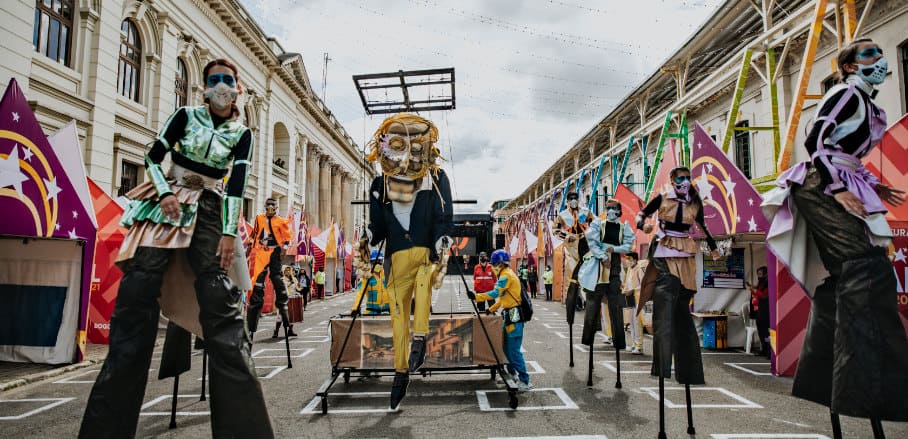The New Face of Bogotá’s Bronx
Bogotá’s Bronx used to be an area infamous for crime and violence. Gabriel Ortiz van Meerbeke outlines how the arts and the cultural industry are transforming the area into a liveable district.
Cloudy skies and social protests against the national government did not stop ten rappers and forty young professional musicians from Bogotá’s Symphonic Orchestra from performing for the first time in the Bronx Distrito Creativo. The story of how this unique musical collaboration came about reflects not only the development of Bogotá’s first creative district but also the city’s commitment to promoting culture and the creative industries as the best way to make a more liveable city.
An Area Forbidden for Most Citizens
Yan Carlos is one of the hip-hop artists who performed that rainy day. He used to live in an area of Bogotá that was forbidden for most of its citizens. Dubbed “El Bronx”, in reference to New York’s neighbourhood, it was controlled by local mafias that dealt in all kinds of illicit business, including human and drug trafficking. However, this was also a place where homeless people could find a roof, where families lived, couples fell in love, and rappers composed songs about their lives on the street.
In 2016, the city administration decided to intervene in ‘the Bronx’ and, after a military operation, demolished most of the neighbourhood’s buildings. Out of the 2,000 people that were displaced, 500, including Yan Carlos, opted to access the social services that the local government offered to all of them, which included housing, therapy, and professional training. The remaining residents simply did not trust the administration or did not want to renounce their freedom and follow the rules of these support systems. A fundamental question remained, however, what the city administration would do with the vacant lots in this area.

Yan Carlos rapping © Andrés Rincón
Furthermore, the Bronx sits next to two heritage sites: the former School of Medicine of the National University of Colombia and a building that used to house the Natural Resources Laboratory of the Ministry of Industry, both neoclassical constructions built around 1930. Unfortunately, the Laboratory, locally known as the Flute, was falling apart and the “Faculty”, owned by the military, was closed to the general public. Therefore, the city administration also had the responsibility to safeguard the historical buildings of this area. Given both that the military already had a stake in this neighbourhood and that it was perceived as an unsafe place, an obvious solution would have been to construct a police station.
Raising our Voices! Transforming the Community through Arts and Culture
It was then that we, the cultural sector, collectively raised our voices and argued that the arts and creative industries are the best way to harness the potential of our community and transform our surroundings! This would include rescuing and giving back the two heritage buildings to the community. Thus, the Bronx Distrito Creativo (BDC for short), the first creative district of Colombia, came to be: 35,000 square metres devoted to the exchange of knowledge and creativity, as well as a venue for public concerts and events, and Colombia’s first public fabrication laboratory.
Despite its recent reputation, this part of Bogotá has always been a vibrant sector full of history, local businesses, and a deep sense of community. According to the latest georeference exercise conducted by Fundación Gilberto Alzate Avendaño (FUGA), a public entity in charge of promoting arts and culture in the city centre, there are over 11,500 cultural agents, 122 venues, and three creative districts in Bogotá’s historical downtown. In Los Mártires alone, the borough where the BDC is located, there are almost 3,800 cultural agents, including traditional crafts such as carpentry, wicker, and marble work but also printing companies, design firms, and second-hand clothing shops.

Concert in La Milla © Andrés Rincón
Given this diversity of cultural and artistic businesses, it was only natural to create a public venue that would attract not only talented local entrepreneurs but also invite citizens from across Bogotá to reclaim this neighbourhood and change the social dynamics around it. To do this, FUGA promoted concerts and events in the public space between the Flute and the Faculty, which was nicknamed by the Military the “La Milla” (the Mile) because recruits had to run a mile in this open space. This was certainly a risky move given the reputation of this area, but it certainly paid off: for the first concert in La Milla we expected 500 people and almost 3,000 arrived! In total, we have had over 200 events where more than 60,000 had the opportunity to see this area in a new light, through live music, theatre, and contemporary dance.
Have the Community Make Their Own Space
To mitigate the possible gentrification effects that a project of this magnitude could have on the community, FUGA had a two-pronged approach: on the one hand, strengthening local businesses in Los Mártires and, on the other, creating a social co-laboratory in charge of honouring the memory of the former residents of the Bronx. Thus, we did not want the BDC to simply attract outsiders but rather to become a space which the Los Mártires community could make their own.
Parallel to the design of the architectural plans for the structural reinforcement and renovation of the two heritage sites, we also started a georeferencing exercise on the creative and cultural businesses of Bogotá’s historic downtown. This allowed us to identify not only how many but also what kind of entrepreneurs could benefit from the BDC in the future and invite some of them to actively take part in the different shows, fairs, and activities that we are promoting in La Milla. So, for example, the “Vronx 60” was the first speciality coffee shop opened on the south side of the BDC, a harsh industrial area dedicated almost exclusively to mechanical workshops and automobile repairs. And in all the events that we have in La Milla, we are always treated with some of the best Colombian coffee that this new enterprise has to offer.

Community outreach and social co-laboratory in la “Esquina Redonda” © Andrés Rincón
Community Work and Remembrance
As to the second strategy, the social co-laboratory will be housed in the only building that was left standing after the 2016 intervention. Nicknamed the “La Esquina Redonda” (the Round Corner) because it has a rounded façade, it is located at the former entrance of this neighbourhood. Currently, it is a participatory centre devoted to community work and a site of remembrance. In fact, it was the community of this neighbourhood who requested a space where we could honour the memory of the people who used to live there.
La Esquina Redonda is the place where Yan Carlos learned how to work within the public sector with all its messy requirements of papers and documentation. Here he works alongside the FUGA team, the National Museum of Colombia, and Bogotá’s Museum, creating the museography script and itinerant exhibitions that seek to investigate not only the past of this particular neighbourhood but to explain how certain excluded subjects (such as homeless people and drug users) come to inhabit a city. Yan Carlos is also one of the guides in charge of showing what this place will be in the future, and recently presented to a United Nations delegation what the BDC has already accomplished.
The Bronx Distrito Creativo is a place that allows a young man like Yan Carlos not only to make a living but also to pursue his dream of being a famous rapper. A venue where unusual collaborations occur, and citizens are reclaiming a space that was forbidden for them. In short, BDC is a project that has transformed a neighbourhood with a complicated history into a hub where creativity, the arts, and the creative industries are the main driver for a more inclusive city.
- The New Face of Bogotá’s Bronx - 17. May 2022
